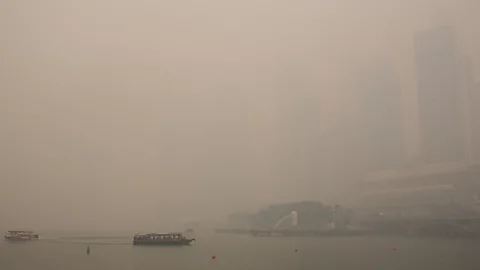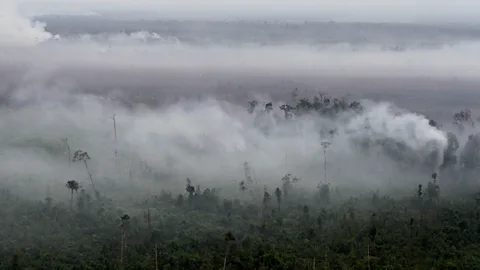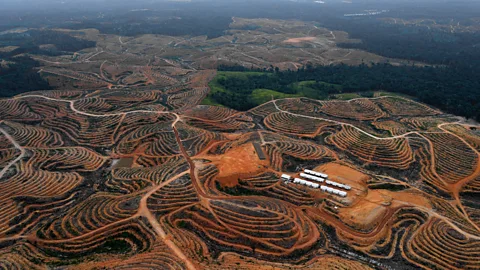The choking problem of Asia’s air pollution

A haze periodically drifts over parts of Asia. What is it, and can anything be done? Mike Ives reports.
At the age of 13, Tan Yi Han could not see the edge of his schoolyard. It was 1998 in Singapore, the wealthy city-state known for its tidy streets and clean, green image. But for much of that particular school year, clouds of smoke shrouded the skyline. The record-setting air pollution, which had begun in 1997 and lasted for months, caused a 30% spike in hospital visits. It would later be remembered as one of South East Asia’s worst-ever “haze episodes”.
Haze episodes have occurred in South East Asia nearly every year since. Back in 1998, and for years afterwards, Tan didn’t think too deeply about them. Yet at some point in his late 20s, he began to wonder: where did the haze come from? And why did it keep coming back?
Despite growing fears that this haze could cause serious health issues, the problem remains as opaque as the smoke itself.
Charcoal landscape
In the summer of 2013, a plane carried Tan over the Straits of Malacca to Pekanbaru, the capital of Riau province, the largest palm-oil production region in Indonesia. Tan, then a 28-year-old financial consultant, was volunteering with the Global Environment Centre, a Malaysian group that has worked for years to prevent and mitigate haze. He travelled to the heart of neighbouring Indonesia, just after a record-breaking haze episode hit peninsular Malaysia.
On a driving tour in Riau, he saw endless acres of burned-out landscapes. Fires had turned swampy peat bogs, the area’s natural vegetation, into land whose parched surface resembled charcoal. These fires dry out the peatlands for agricultural uses, mainly the cultivation of oil palms. But in some villages, fires had even destroyed existing oil palm trees that belonged to multinational companies or local farmers.

Tan had a memorable encounter in the village of Rantau Bais. A couple there plied him with tea and snacks, then quietly asked if he could spare any of his own food for them. Their daughter had developed a respiratory problem because of the haze. The surprise medical bill, coupled with the fire destroying their oil palm crops, had left them penniless and hungry.
Until that moment, he had mostly thought of peat blazes as “forest fires,” as they are often called in media reports. But here was a visceral reminder that the fires affect working land and real people. “It really touched me,” said Tan. “I made a promise to myself that I’d do my best to prevent them from suffering from fires again.”
It was an issue, he felt, that required far more public discussion – and when the time was right, action. “I must get more people involved,” he had thought, “and turn this into a movement.”
Impact on health
Hazy skies may all look similar, but the emissions from any particular source are unique. Vehicle and factory emissions have been analysed for decades in high-income countries, but haze smoke, and its impact on health, is not well understood. “Not many people have investigated it even though it’s a very important phenomenon,” said Mikinori Kuwata, an atmospheric chemist at Singapore’s Nanyang Technological University.
Unlike factory and vehicle emissions, wildfire smoke is not regulated by tailpipe scrubbers, catalytic converters or other pollution-mitigating applications. The composition of the smoke also varies widely according to the type of material that is burning. Peatlands, for example, typically take a longer time to burn than drier matter – just as a damp piece of wood takes longer to burn in a campfire. According to the US Environmental Protection Agency, peat fires burn at lower temperatures and produce smoke that is more harmful, and in larger quantities, than the average forest fire or grassland fire does.

The emissions from a given peat fire will largely depend on the peat’s composition, its burning temperature and how far below the ground the fire occurs. But such details aren’t yet available in Indonesia, whose peatlands cover an area roughly the size of the United Kingdom. As a result, Kuwata told me, “We do not have a very reliable inventory” of the country’s peatland fire data. Kuwata burns Indonesian peat in his Singapore laboratory to study its chemical properties, but his work is limited, he said, because he can never be sure whether his experiments mirror reality.
Indonesia has an enormous repository of tropical peatlands – and, for a generation, areas of these have been burned to prepare the land for the cultivation of oil palms. Peat smoke now contributes around 40% of Indonesia’s overall greenhouse gas emissions. Palm oil is an ingredient in a range of consumer products,from lipstick to ice cream. Yet it has also helped to give its source country the dubious distinction of being the world’s third-largest greenhouse gas emitter after China and the US – as well as a leading source of hazardous smoke haze.
Cash crop
What’s more, peat fires are notoriously hard to predict and extinguish. They start and spread easily, and sometimes uncontrollably, depending on conditions like wind speed, the depth of the soil and the dryness of the air.
“It’s really hard to know how bad a fire will be when it starts,” according to Dedy Tarsedi, a farmer in the Riau village of Bungaraya. We were sitting in Riau, at a roadside café flanked by oil palm trees. Tarsedi told me that oil palm is the crop of choice for Bungaraya farmers because it is more valuable than paddy rice. A hectare of oil palm, he said, typically earns a farmer around 48 million Indonesian rupiah (nearly US$4,000) per year instead of 40 million rupiah a year for rice.

But as oil palm cultivation has increased in the village, so have fires. And they affect both corporate plantations and smallholder farmers.
“If a fire happens and we can’t control it, we’ll report it,” said Maman, a Bungaraya farmer. But sometimes, even helicopters are powerless to stop the burning, he added. “And during the really bad fires, a lot of the kids cough and end up at the clinic with health problems.”
In 2009, Indonesia passed a law banning fires on peat plantations. Farmers in Bungaraya told me that, as a result, they had started to clear peat bogs manually, without using fire. But Tarsedi said manual clearance is more labour-intensive and requires extra fertilisers. And that, he said, requires extra time and money that most farmers don’t want to part with.
Respiratory risk
When the wind blows from the west, smoke can whip east across the Straits of Malacca and into both Singapore and Kuala Lumpur (the capital of nearby Malaysia) – collectively home to about seven million people. South East Asia is not the only place where the burning of vegetation occurs over large areas; most of the world’s fires occur in Africa and South America. But South East Asia’s fires are unique, says Miriam Marlier, an atmospheric researcher at Columbia University, because they occur so close to dense urban centres.
There are no comprehensive studies on how repeated exposure to peat smoke affects human health over the long term, much less how peat smoke’s chemical properties differ from other kinds of biomass smoke. Yet emerging research offers early clues.

US researchers have found that peat fires in the southern states during the summer of 2008 caused a spike in emergency room visits for heart failure and asthma-related respiratory complications. In a follow-up study, published in June 2014, they burned semi-charred peat from the fires in the vicinity of lab mice. Subsequent pulmonary problems in the mice were mainly linked to coarser-grained smoke particles and cardiac problems to finer-grained particles.
A widely cited 2012 study, published in the journal Environmental Health Perspectives, estimated that about 339,000 deaths worldwide between 1997 and 2006 were associated with forest, grass and peat fires.
Chronic problems
A primary concern from a health perspective is that peat fires tend to generate larger amounts of fine-grained particulate matter, called PM2.5, than normal forest fires. That is worrying mainly because finer-grained particles are thought to penetrate further into the bloodstream than coarser ones do, posing a potentially higher risk to the heart and other internal organs. Finer-grained particles are also harder to block with the simple surgical masks that many people in Asian cities have traditionally worn as protection against air pollution.

Some scientists suggest that peat smoke’s long-term effects on humans may be broadly similar to those of urban air pollution, which also includes PM2.5 particles. No one is sure because so little research has been done to test the theory.
Rajasekhar Balasubramanian, an American environmental engineer who studies haze at the National University of Singapore, speculates that long-term exposure to haze episodes could potentially make the population less healthy over time, even if people continue to live long lives. In a 2013 study, he and his colleagues found that the air above Singapore during a smoke haze episode contained arsenic, chromium, cadmium and other carcinogenic elements.
Tricky to predict
Yet there still is no coordinated international effort to analyse haze in a truly interdisciplinary fashion. That is partly due to the sporadic and unpredictable nature of haze. Another problem, Balasubramanian said, is that the general public does not yet view haze as a serious health threat. “People view it as, ‘Oh, yeah, it’s a problem that occurs in Indonesia’,” he told me one afternoon in his office at the National University of Singapore. For governments and funding bodies, “the priority’s more mitigation: how to mitigate human exposure to this haze issue, rather than to study the problem itself”.

The task of mitigating pollution is also clouded by politics. Countries in South East Asia have little control over what blows across their borders: unlike the European Union, the Association of Southeast Asian Nations (ASEAN) lacks the legal authority to force its members to act against their own interests.
Grass roots
Will Tan Yi Han be able to change enough minds, then? In early 2014, he founded a citizens’ organisation called People’s Movement to Stop Haze, or PM Haze, to kick-start the discussion. “My gut feeling is, we need influence,” Tan said at a Sunday-evening PM Haze meeting. However, the scale of the task he faces was apparent: there was only one other participant: Putera Zenata, an Indonesian schoolteacher who had joined the group after finding Tan online. The venue was Zenata’s modest apartment in a middle-class Singapore neighbourhood.
In June 2014, one of Tan’s hometown newspapers, the Independent, dubbed him “Singapore’s intrepid haze fighter”. But PM Haze, with 10 active members and no outside funding, is well behind many established advocacy and research groups that fight air pollution elsewhere in Asia.
For the moment, Tan said, PM Haze is simply trying to learn about the problem, in all its complexity, and then communicate its findings to the Singaporean public.
“My personal goal is to stop haze by 2023,” he added casually.
Whether that is a pipe dream, however, remains to be seen.
This is an edited version of an article originally published by Mosaic, and is reproduced under a Creative Commons licence. For more about the issues around this story, visit Mosaic’s website here.
